This post may contain affiliate links. Please read my disclosure.
This Spicy Korean Ramen is served with thinly sliced pork belly and seasoned with Korean ingredients such as gochugaru, doenjang and gochujang!
It’s packed with umami flavor and takes just an hour to make!
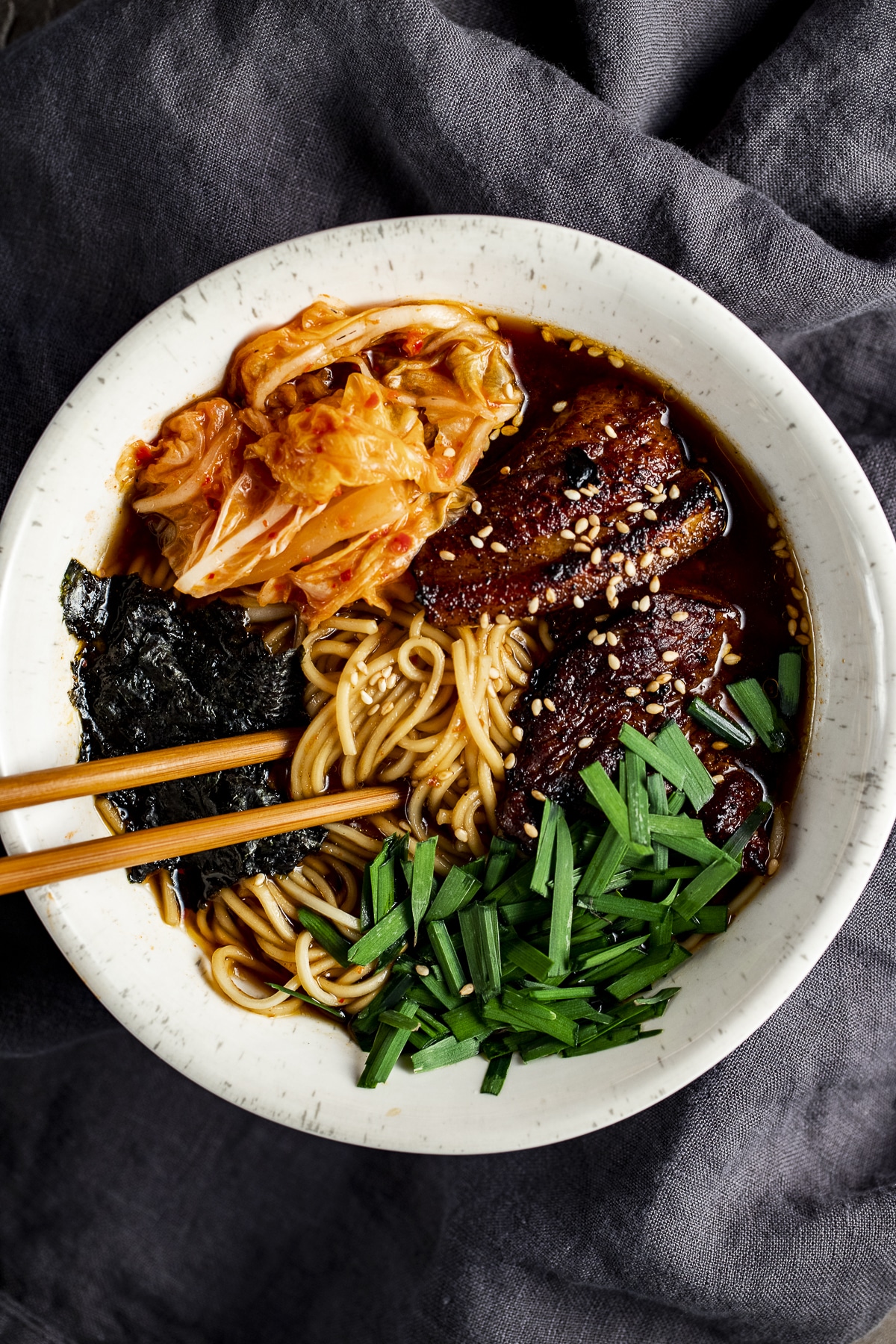
And like the title says, this is NOT an instant ramen recipe. It is quick, and it is easy, but this is not pre-packaged instant Korean ramen.
Every time I make a new ramen recipe, it instantly becomes my new favorite!
Truth be told, I love them all! This shio ramen is loaded with so many delicious toppings, including seasoned bamboo shoots, and this spicy chicken ramen is super easy and flavorful!
And this birria ramen might be one of my all time favorites, with it's rich beef and Mexican spices.
And for a quick ramen recipe, with tender caramelized pork, I always turn to this Instant Pot ramen.
Each of these ramen recipes offers a different flavor experience, but this Korean ramen recipe is packed with so much more intense flavor!
And the thinly sliced pork belly is melt-in-your-mouth delicious!
While the pork totally works as a stand alone topping on this ramen, we love to serve it with kimchi and soft boiled eggs, like these ramen eggs or these sous vide soft boiled eggs.
Jump to:
What is Korean Ramen?
Korean ramen is not actually a real thing. It's a mash up of Japanese ramen infused with Korean flavors like gochujang, doenjang, Korean chili spice and kimchi.
With the popularity of ramen growing all over the US, I decided to get creative and introduce some new flavors into traditional ramen. This Korean ramen is just that - not traditional, but oh-so-delicious!
The closet thing is actually Korean ramyeon, which is really just instant ramen with a Korean twist that is wildly popular in Korea.
Why this recipe works
- Even though the pork belly needs to marinate for 30 minutes, it cooks fast, so this ramen can be ready in just an hour!
- The pork belly is thinly sliced, so it cooks quickly and the marinade helps keep it tender, flavorful and juicy!
- You can make this ramen in advance so it’s great for meal prep! Just store the pork belly, broth and cooked noodles separately, then reheat and assemble when ready to enjoy!
Want to Save This Recipe?
Enter your email & I'll send it to your inbox. Plus, get great new recipes from me every week!
By submitting this form, you consent to receive emails from Went Here 8 This.
Ingredients
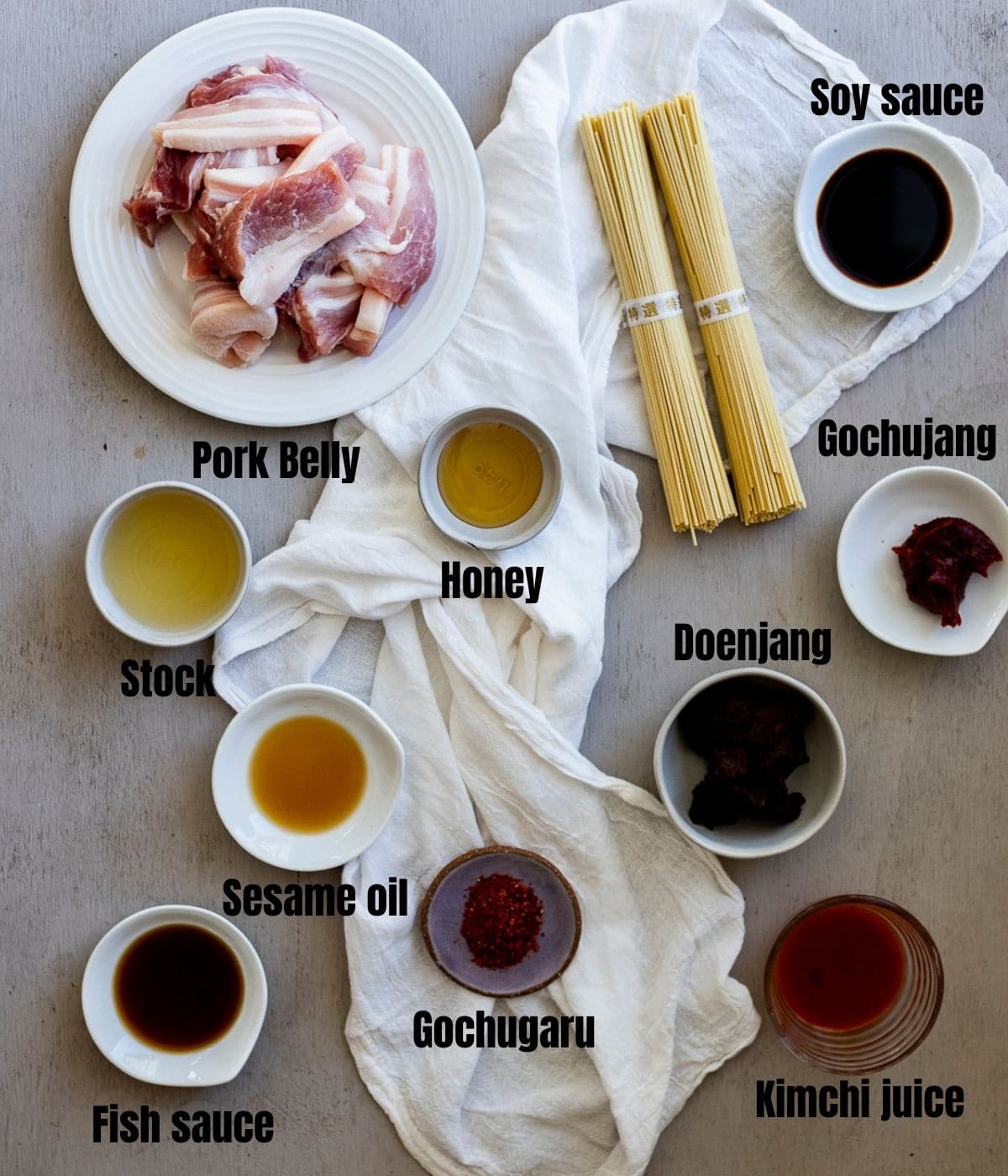
For a full list of ingredients and quantities, check out the recipe card at the end of this post.
You’ll need ½ a pound of pork belly for this recipe, cut into thin slices.
Pork belly is a boneless, yet fatty, cut of pork that is taken from the pig’s belly. I usually buy a center cut and go for the meatiest piece I can find. While the high fat content adds flavor, you still want a good meat to fat ratio.
The broth seasoning includes 1 teaspoon of gochugaru. This is a Korean coarsely ground chili, with a slightly sweet, spicy and smoky flavor. It’s usually made from sun dried chilies without the seeds. If you don't have gochugaru, you can use dried chili flakes or chipotle powder as a substitute.
You’ll also need 3 tablespoons of doenjang (a fermented soybean paste) for the broth, as well as 1-3 tablespoons of gochujang (just adjust based on your spice preference).
Gochujang is a Korean fermented red chili paste that has sweet, savory and spicy flavors. If you like your ramen extra spicy, use 3 tablespoons in the broth. You’ll also need gochujang for the pork marinade.
For the ramen noodles, I used 8 ounces of dried ramen noodles (cooked to package instructions) but you can also use fresh ramen noodles, if you prefer.
Step by step instructions
Combine all the marinade ingredients in a bowl and add the pork belly. Let marinate for at least 30 minutes, or up to 2 hours.

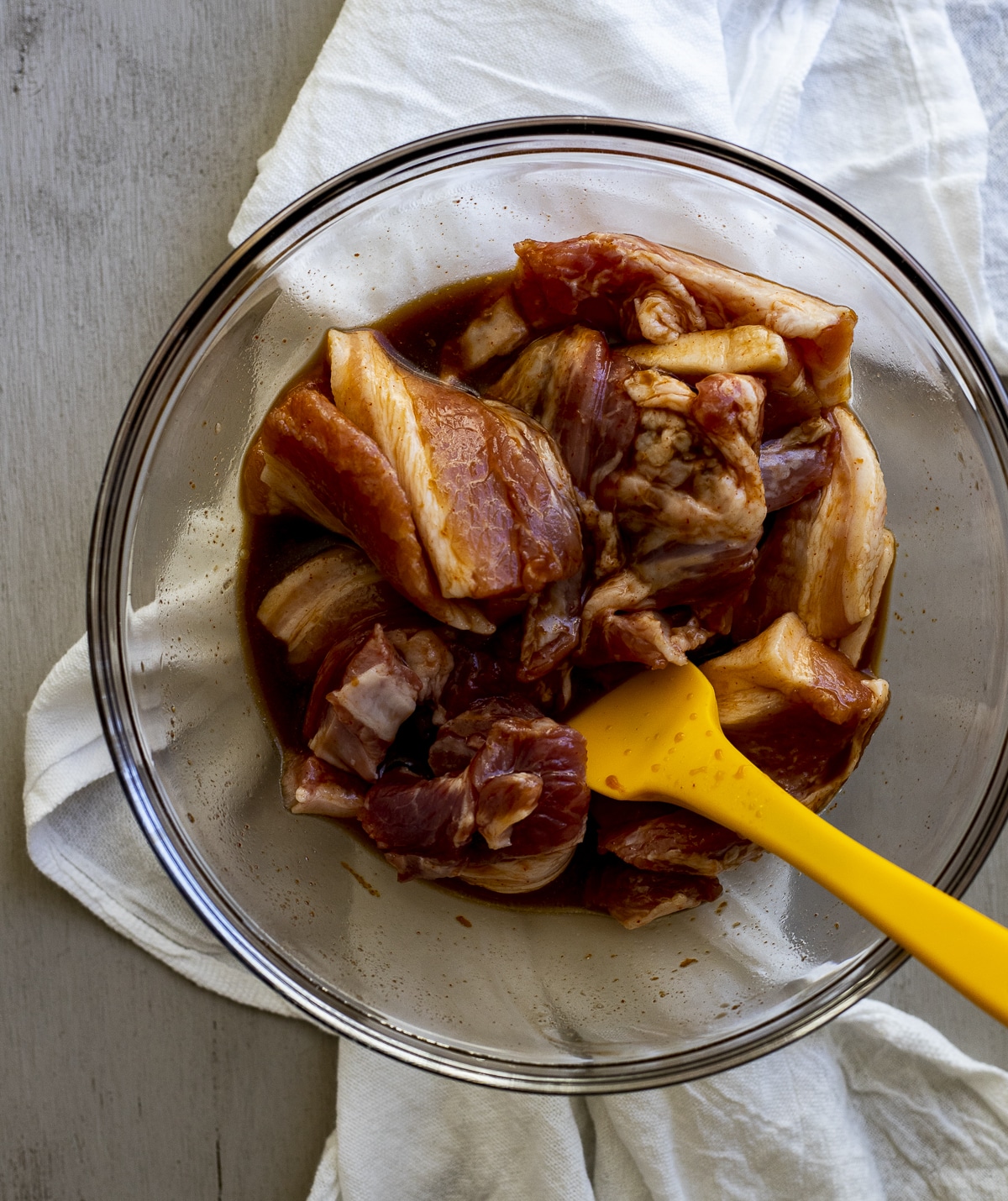
Heat a Dutch oven over medium heat and add 1 tablespoon of cooking oil.
Cook the pork belly until browned and cooked through, about 3-4 minutes per side. **You'll need to cook it in 2 batches.
Remove the pork belly and set aside.
Add the remaining ingredients (except toppings) and bring to a simmer for 10 minutes.
Strain and serve in bowls over noodles with toppings and pork belly slices.
Serving Options
You can use any ramen toppings you'd like for this Korean ramen, but here are some of our favs!
- Kimchi
- marinated ramen eggs
- Sesame seeds, a light drizzle of sesame oil or any crushed nuts
- Green onion, fried garlic or fried shallots
- A piece of American cheese (like this rabokki!)
- Pieces of nori or furikake
- Chili crisp
- You can also add tofu, shiitake mushrooms, sliced carrots, shrimp, or anything else you'd like to the broth as it cooks
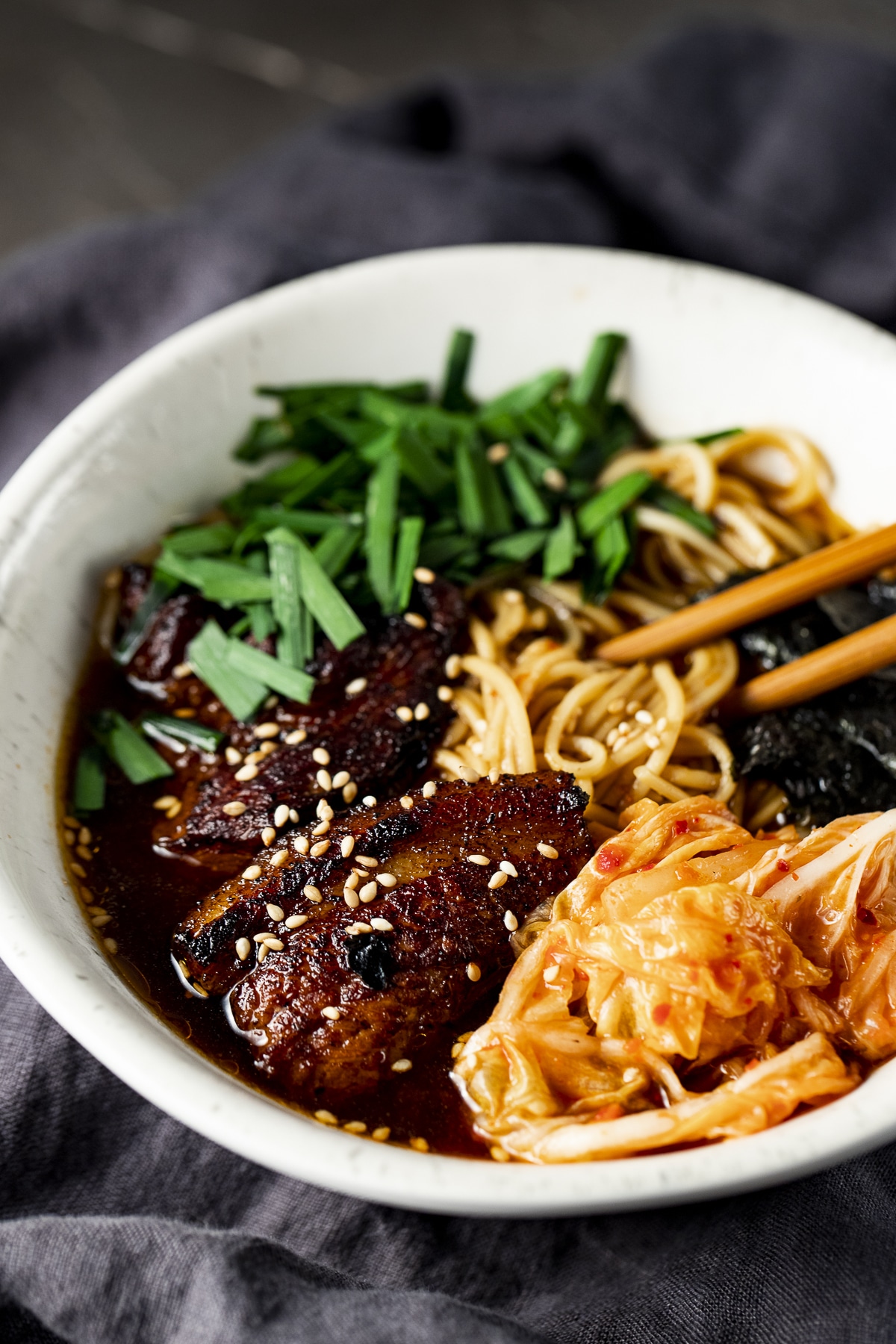
Expert tips
- For quick and even browning, you’ll want to cook the pork belly in a single layer. Depending on the size of your Dutch oven, this means cooking it in at least two batches.
- If you’re adding soft boiled ramen eggs as a topping, I recommend making them in advance as they need to marinate overnight.
- If you think you’ll have leftovers, be sure to store the noodles, pork belly and broth separately. If combined, the noodles will soak up the broth and get mushy.
- To control the saltiness of your ramen, I recommend using a homemade or low sodium chicken broth.
- If you’re not a fan of spicy flavor, just reduce the amount of gochujang you use.
- I don’t recommend substituting for the gochujang and doenjang. They’re absolutely necessary for the authentic Korean flavors. Check out this post to learn a little more about essential Korean ingredients.
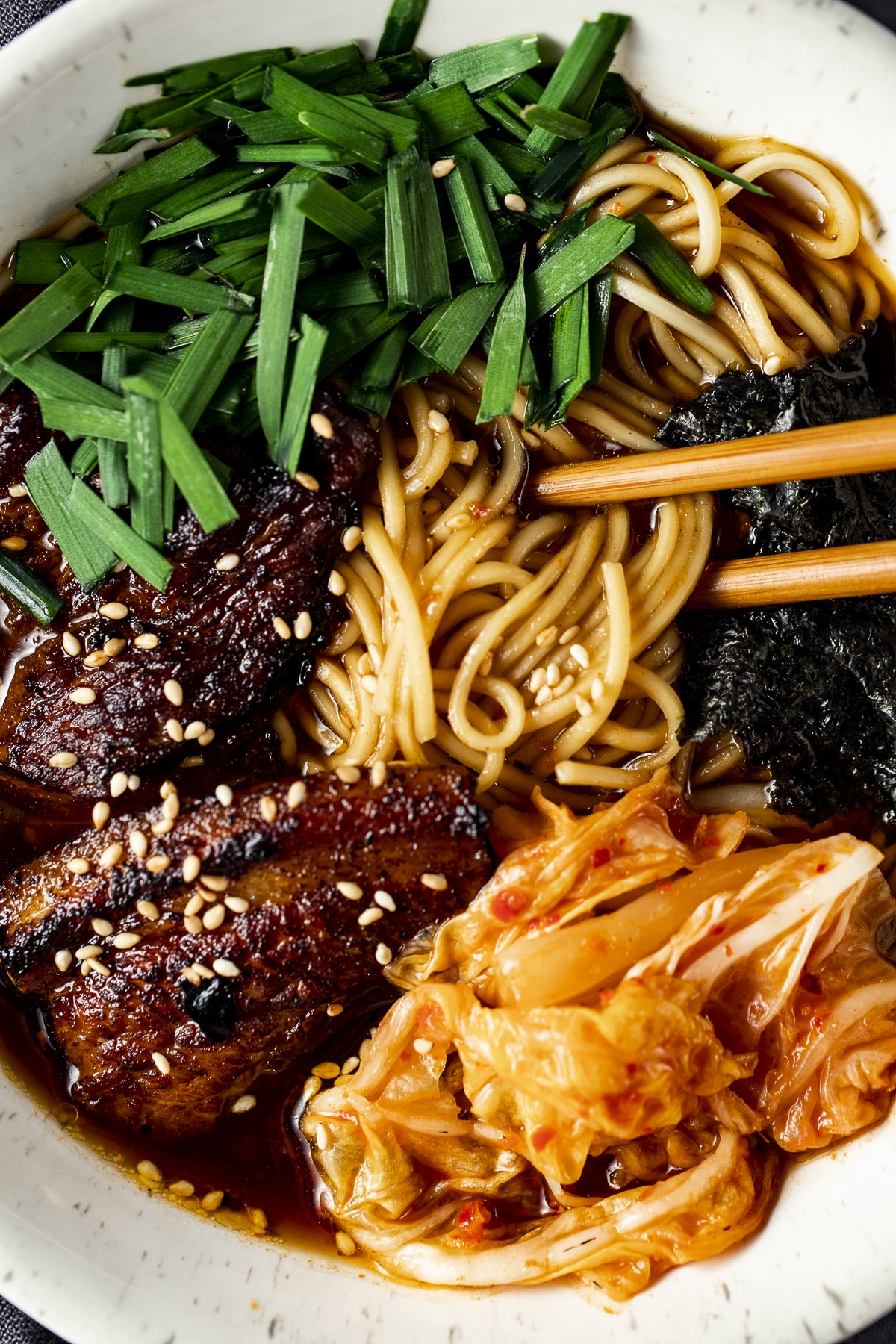
Frequently Asked Questions
Korean ramen is not actually a real thing. It's a mash up of Japanese ramen infused with Korean flavors like gochujang, doenjang, Korean chili spice and kimchi.
- Kimchi
- Green onions
- Sesame seeds/oil
- Tofu
- Nori
- American cheese
- Chilies
For the most juicy and tender pork belly, I recommend marinating it. This can be done in as little as 30 minutes or up to 2 hours. As marinating helps tenderize and flavor meats, I always recommend that this step not be skipped!
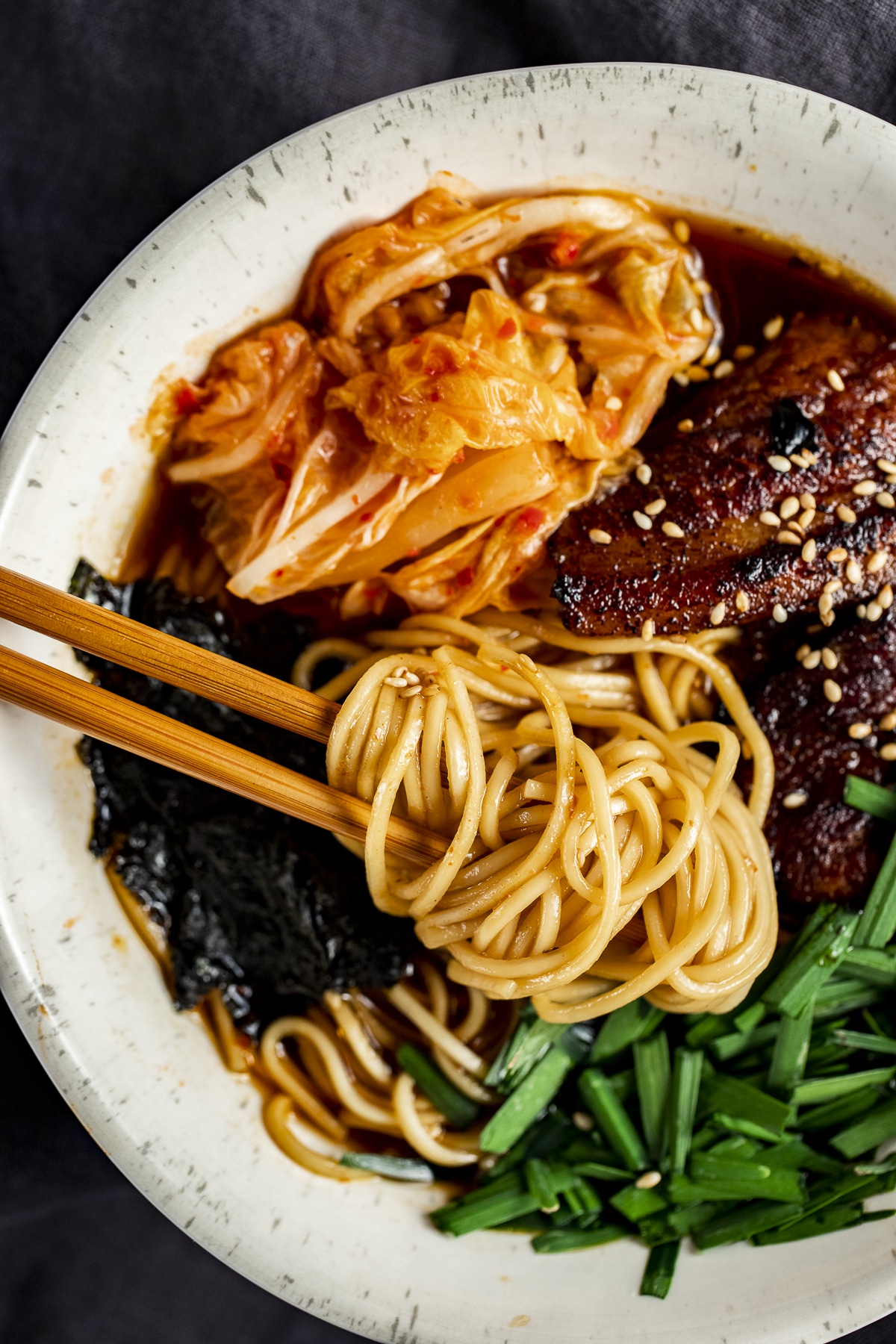
Storage and Reheating Instructions
To make in advance, you can cook the pork belly and broth according to the recipe instructions and store them separately in the fridge for up to 3 days.
You can also cook the noodles in advance and store them in a separate container in the fridge, or cook them just before serving. When ready to serve, just reheat everything and assemble the ramen in bowls with your desired toppings.
You can also freeze the broth and the pork belly in separate airtight containers for up to 6 months. Just defrost in the fridge overnight before reheating and serving.
I don’t recommend freezing cooked noodles as they may get mushy once defrosted and reheated.
More Korean inspired recipes
If you love this recipe, please leave a star rating and a comment below and let us know your favorite thing about it. We'd also love to connect on Instagram! Follow us at @went_here_8_this for awesome recipes and all sorts of fun food stuff 🙂
Recipe
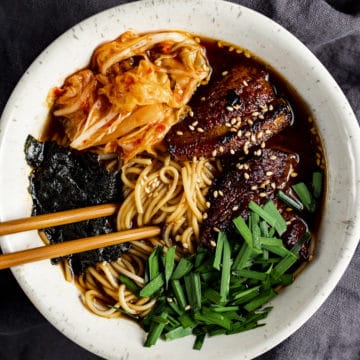
Spicy Korean Ramen
Ingredients
- ½ pound pork belly cut in thin slices
- 1 tablespoon cooking oil
- 6 cups chicken stock
- 1 tablespoon fish sauce
- 1 teaspoon gochugaru
- 3 tablespoons doenjang
- 1-3 tablespoons gochujang adjust based on spice preference
- 1 tablespoon soy sauce
- 2 tablespoons kimchi juice
- 1 teaspoon sesame oil
- 8 ounces dried ramen noodles cooked and drained to package instructions
Pork Belly Marinade:
- 1 tablespoon soy sauce
- 1 teaspoon gochujang
- ½ teaspoon sesame oil
- ¼ cup chicken stock
- 1 teaspoon honey
Toppings:
- kimchi
- hard or soft boiled eggs
- scallions
- nori
- sesame seeds
Instructions
- Combine all the marinade ingredients in a bowl and add the pork belly. Let marinate for at least 30 minutes, up to 2 hours.
- Heat a Dutch oven over medium heat and add 1 tablespoon cooking oil.
- Cook the pork belly until browned and cooked through, about 3-4 minutes per side. (You'll need to cook it in 2 batches).
- Remove the pork belly and set aside.
- Add the remaining ingredients (except toppings) and bring to a simmer for 10 minutes.
- Strain and serve in bowls over noodles with toppings and pork belly slices.
Expert Tips:
- For quick and even browning, you’ll want to cook the pork belly in a single layer. Depending on the size of your Dutch oven, this means cooking it in at least two batches.
- If you’re adding soft boiled ramen eggs as a topping, I recommend making them in advance as they need to marinate overnight.
- If you think you’ll have leftovers, be sure to store the noodles, pork belly and broth separately. If combined, the noodles will soak up the broth and get mushy.
- To control the saltiness of your ramen, I recommend using a homemade or low sodium chicken broth.
- If you’re not a fan of spicy flavor, just reduce the amount of gochujang you use.
- I don’t recommend substituting for the gochujang and doenjang. They’re absolutely necessary for the authentic Korean flavors. Check out this post to learn a little more about essential Korean ingredients.
Nutrition
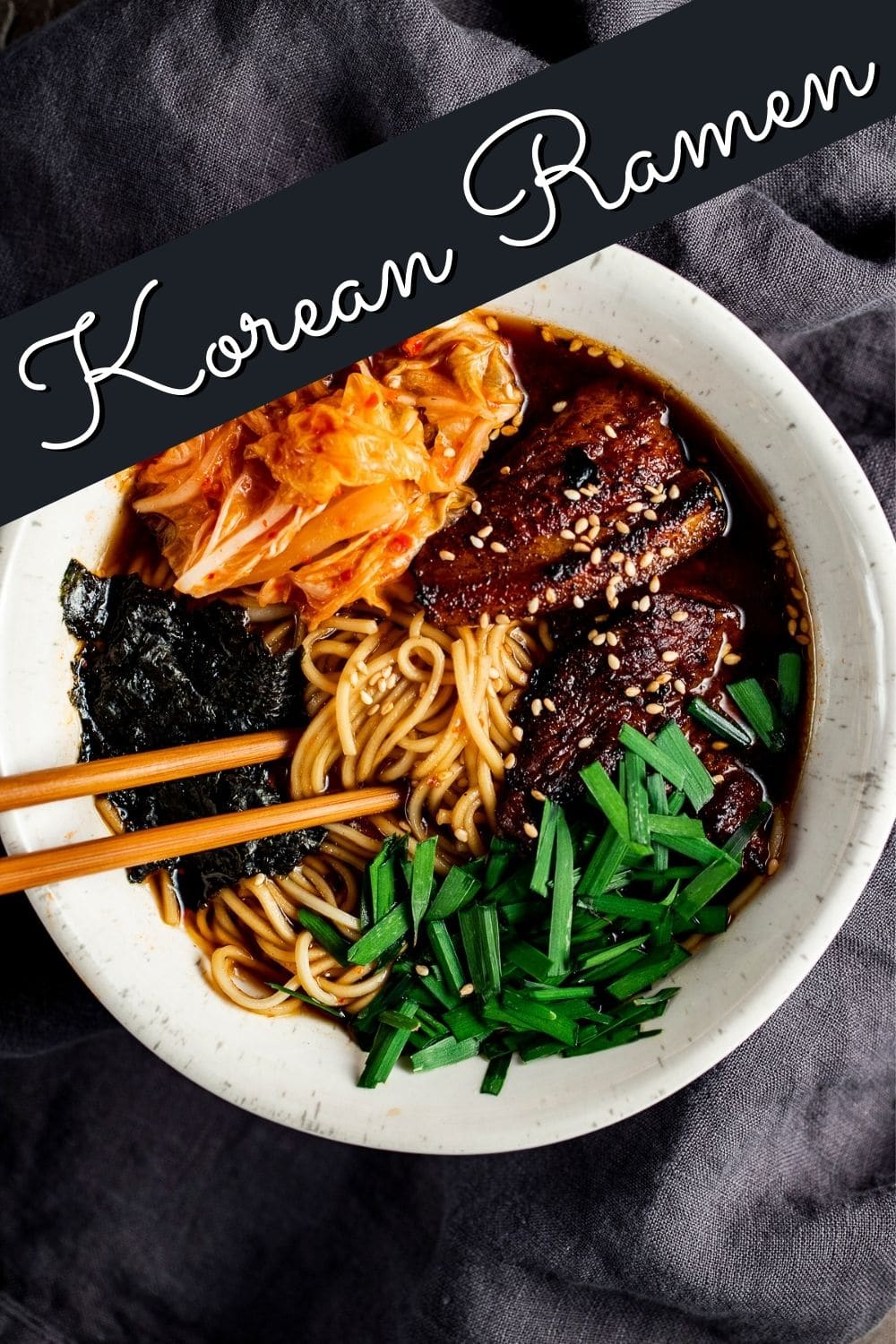







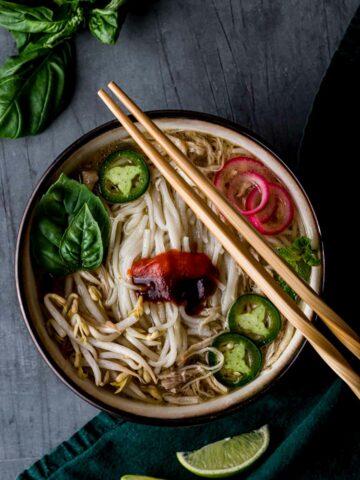


Sally
This came out so good! It was nice and spicy but not too spicy for my family. I loved that it was so easy to make too. I found all the ingredients at a local Asian grocery store. Thanks!
Danielle
I'm so glad you liked it!